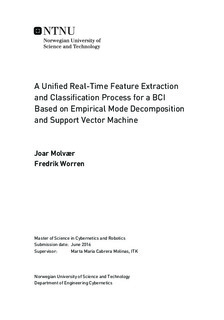| dc.description.abstract | This thesis has studied and implemented a data-driven process combining EEG feature extraction based on empirical mode decomposition (EMD) and classification using a support vector machine (SVM). The experimental paradigm followed a persistent approach using professional EEG acquisition equipment. Eight healthy, right-handed subjects were recruited, all signing consent forms prior to their respective recording session. Each session consisted of 70 trials for three different conditions, namely left fist clenching, right fist clenching, and a neutral condition in which no movement occurred. The EEG data were recorded using a 256-electrode Geodesic Sensor Net (GSN).
The data analysis were performed using the adaptive EMD method, in which the oscillatory modes of the EEG signals were extracted and expressed by intrinsic mode functions (IMFs). The IMFs were normalized and their corresponding Hilbert transforms were computed. This process is referred to as the normalized Hilbert transform, from which a meaningful instantaneous frequency and amplitude can be obtained. The time-frequency solutions were visualized in Hilbert spectra, and a decrease in the signal power was recognized during left and right hand movements, known as event-related desynchronization (ERD). The mean ERD during the three conditions were calculated and utilized as features for the classification scheme. A given number of features were employed as support vectors, and the features of the remaining trials were predicted using an SVM classifier. Classification accuracies of up to 95% were acquired from multiple subjects, along with an average accuracy of 87.86% when differentiating left and right fist clenching. The computational effort of this unified process is found to be within the real-time demands of a brain-computer interface (BCI). | |

